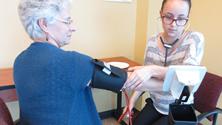What is an Old-Fashioned Practice?
An Old-Fashioned Practice is one very set in its ways and that has perhaps been in practice for a long time. The practice generally sees its years of practice and experience as more valuable in making decisions about care than adherence to evidence-based guidelines. It is not uncommon that an Old-Fashioned Practice also values relationships with patients over providing evidence-based care, thus things like prescribing six months of an opioid, contrary to updated guidelines, happens in the spirit of making a long-known patient feel comfortable and supported.
Example from a practice facilitator:
This “old-fashioned” practice was a small coastal practice, with four providers and 18 total staff. Its owner was an older physician who did not agree with current hypertension guidelines. While he didn’t see the value in quality improvement, he knew they had to do better on their quality reporting. At first it was difficult to convince the practice to review the latest evidence-based guidelines and try new workflows. The providers were set in their ways. While they didn’t buy in to the specific measurements in the new guidelines, they did agree on some of the key components of the hypertension guideline and communicated a standard approach for patients with high blood pressure. After completing several small changes and indications of improvements, the providers started to get excited and picked up steam. Now they are a high-functioning practice that champions the importance of quality improvement based on evidence-based care, and their team reports less burnout as well.
Self-Management Support Materials
The practice does not have up-to-date patient self-management materials.
This practice frequently has outdated or limited (in terms of supply and/or detail) patient self-management materials. Especially for settings that serve a distinct population, the ability to identify evidence-based and culturally relevant materials can be a challenge. Additionally, locating appropriate materials and making them accessible to staff can be very time consuming, and thus, often results in the patient having to rely on their recollection of the conversation they had with clinical staff regarding their appointment.
Strategies
The practice facilitator should listen to the practice staff to understand the patient population and the needs of the surrounding community. Research examples of current and relevant materials, and help the practice test their use with a few patients and patient family members to discover what works best for both. Once patient materials are selected, help the practice determine the best way for them to obtain and store needed quantities in the correct languages and develop relationships with the sources to procure ongoing updates.
As an example, state-run smoking cessation programs will send practices pamphlets with phone numbers and websites patients can contact directly. Help practices connect to appropriate training resources for clinic staff to learn skills such as lifestyle coaching, diabetic education, motivational interviewing, care management, and other proven methods for improving patients’ self-management skills. One benefit of documenting and utilizing available community organizations is that it can help direct patients to local resources such as fitness centers or community centers.
The practice does not have up-to-date patient self-management materials.
This practice frequently has outdated or limited (in terms of supply and/or detail) patient self-management materials. Especially for settings that serve a distinct population, the ability to identify evidence-based and culturally relevant materials can be a challenge. Additionally, locating appropriate materials and making them accessible to staff can be very time consuming, and thus, often results in the patient having to rely on their recollection of the conversation they had with clinical staff regarding their appointment.
Strategies
The practice facilitator should listen to the practice staff to understand the patient population and the needs of the surrounding community. Research examples of current and relevant materials, and help the practice test their use with a few patients and patient family members to discover what works best for both. Once patient materials are selected, help the practice determine the best way for them to obtain and store needed quantities in the correct languages and develop relationships with the sources to procure ongoing updates.
As an example, state-run smoking cessation programs will send practices pamphlets with phone numbers and websites patients can contact directly. Help practices connect to appropriate training resources for clinic staff to learn skills such as lifestyle coaching, diabetic education, motivational interviewing, care management, and other proven methods for improving patients’ self-management skills. One benefit of documenting and utilizing available community organizations is that it can help direct patients to local resources such as fitness centers or community centers.
Data
The practice can generate data, but one or more members do not trust that it is correct and therefore discount it.
Although the practice can run queries and generate data reports, they often do not have a full understanding of where the data originates and that causes staff to question whether the data are current or accurate. Additionally, an individual clinician may believe, with or without justification, that the data are wrong for their patient panel. They may believe the data generated underrepresent their actual performance, because of incorrect data definitions or inaccurate data capture.
Strategies
A QI culture depends on the staff trusting that the data are correct. Practice facilitators should start by explaining how the data are generated for the reports that the practice runs and work with practice staff to find clinical measures that are not only timely enough to be actionable, but also the most relevant for their population. Often the practice has had prior experience with reports they found to be incorrect, so they may need to be walked through data summaries to build familiarity and trust in the data. Suggest that a clinical staff member look up a sample of 10 to 20 patients and verify accuracy of information. By teaching practice staff how to validate their data, you can decrease anxiety around reporting and empower staff to look at their data in a meaningful way. Finally, encourage one member of the team to become a “power user” – a local resource for the team who spends some time building expertise and comfort with the practice’s systems. Ideally, this team member can include this work as a part of their job description.
QI Team and Project Management
The practice does not have an established quality improvement team or process.
This practice does not have a defined quality improvement team, and instead may have ad hoc groups for each improvement effort. Given the number of local, state, and federal initiatives that a practice might engage in over time, there could be several initiatives, each with independent clinical quality measures and improvement goals, active at the same time without close communication among them. As a result, few opportunities exist to generate discussions across roles, with team members addressing issues individually as they arise, rather than engaging in a team-based approach. If team meetings do occur sporadically, they are often dominated by one or two individuals with many of the team members going unheard, or used for items such as vacation schedules instead of the work of improvement.
Strategies
The practice lacks a systematic way of identifying issues quickly or anticipating bottlenecks, and instead treats problems on a case-by-case basis as they erupt.
This practice addresses issues as they arise rather than establishing systems to monitor activities to quickly identify and address inefficiencies or prevent emerging issues before they arise. The practice team may identify issues and create ideas on how to solve these issues, but it is often ad-hoc and unsustainable. After a problem is addressed and the crisis passed, there is no opportunity to learn from the situation or apply solutions to other areas proactively.
Strategies
A practice facilitator can start by teaching this practice why they should monitor the progress of changes over time. Encourage the team to involve all team members that impact a process so that causes are well understood and unintended consequences from the changes are avoided or mitigated. Help them to sustain the change and to not go back to the old workflow after they stop giving it their focus. Use their example of a past quality improvement project as a way to get buy-in from practice staff since it is an example they can directly relate to. Explain that follow-up on these improvements does not have to be intrusive or overbearing. Help them create a mechanism for quality assurance and for follow-up on identified issues that can be applied uniformly across the entire staff and that does not single people out in a negative way. Basing performance off measurable data points is a great way to do this, because there is a shared framework that can be used to define success and monitor counter measures (Steven’s “Supporting people to quit smoking can have an enormous, lasting impact from” H2N blog). Using the PDSA worksheet in conjunction with encouraging the practice to view its own data can be an effective tool with this practice.
Incorporation of Evidence
Clinicians and staff may not be aware of the most recent evidence-based care guidelines.
The practice’s clinical teams rarely discuss treatment protocols or share their personal approaches, so each team functions as an island, without opportunities to learn from each other or share new evidence. These practices tend to have either very high turnover in clinicians or be the domain of a solo practitioner who relies on their personal experience and training, which may have taken place some time ago. Practices that are more geographically isolated, such as in rural settings, may not have processes in place to identify and share the latest evidence-based care, and may also have fewer opportunities to interact and learn from other community practitioners.
Strategies
Culture
The practice has an aversion to change, so new solutions are hard to implement.
This practice might say things like “We have been doing this for years” or “We already have a workflow in place for that issue.” They may have addressed the problem in the past but lack a structure to ensure they follow up on their work or move on to new goals or approaches. Reluctance by this practice to discuss new ways of working may be tied to their belief that they are already performing quite well, despite indications in their data that there are areas for improvement. In some cases, this overconfident practice can become “straightjacketed” by a need to achieve perfection—only willing to take on new tasks if they can immediately perform them well, and therefore they may be averse to small-scale tests of change.
Strategies
Practice facilitators can run clinical quality measure reports for this practice comparing their performance data against other similar practice data or benchmark data, which can uncover opportunities for improvement. After addressing concerns they have with comparability of the practice or quality of the data, invite them to consider a small test of change, beginning with a simple workflow mapping exercise. After an initial success, people will be more willing to explore new ways. It may also be helpful to expand the number of staff engaged in a topic to get more buy-in. Some practices have used structured trainings followed by staff satisfaction and learning surveys to boost engagement successfully. Overconfidence may occasionally be a coping mechanism for teams reluctant to spend the time or energy examining their processes. Data performance can convince an overconfident practice to establish a quality improvement team and incorporate some of the facilitation strategies.
Data
148QI Team and Project Management
149Incorporation of Evidence
150Self-Management Support Materials
151Culture
152If you have a question about the improvements, action steps, or tools & resources in this module please let us know. We're here to help. And if we can't answer your question, we can probably connect you with someone who can.




